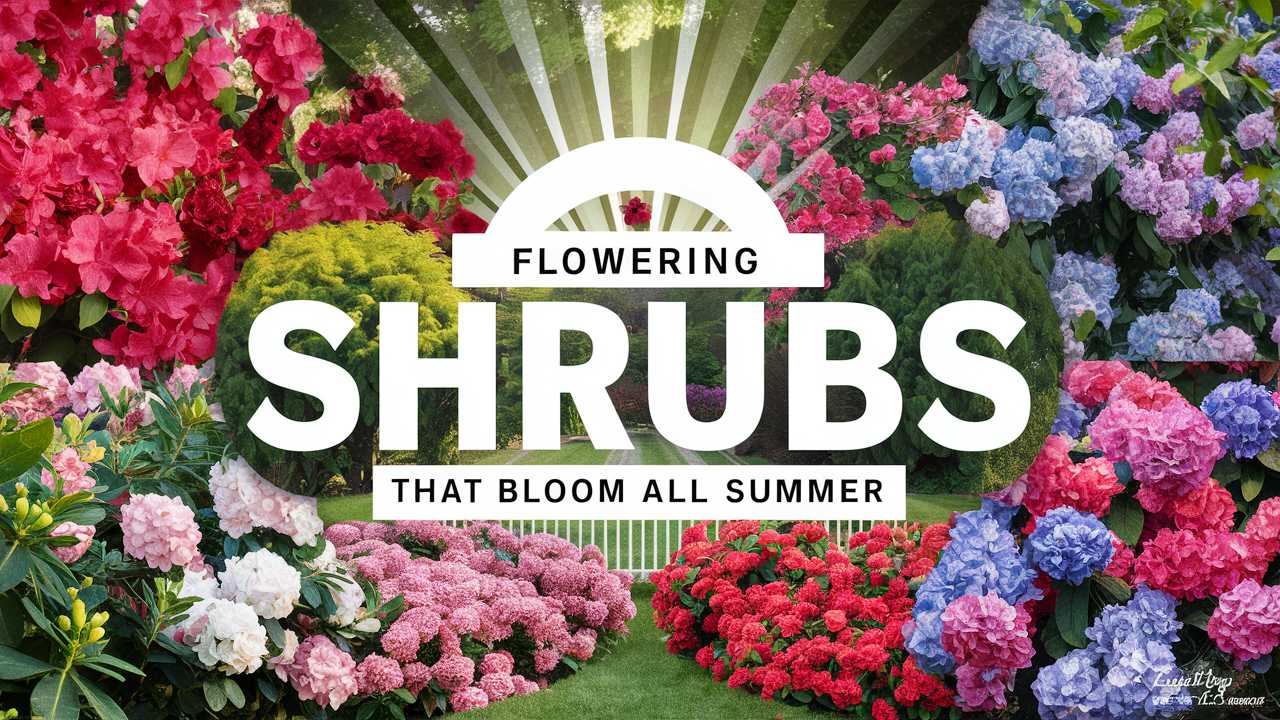In this comprehensive guide, we’ll explore a selection of flowering shrubs that bloom all summer long, ensuring that your garden remains vibrant and alive through the warm months.
Rose of Sharon (Hibiscus syriacus)
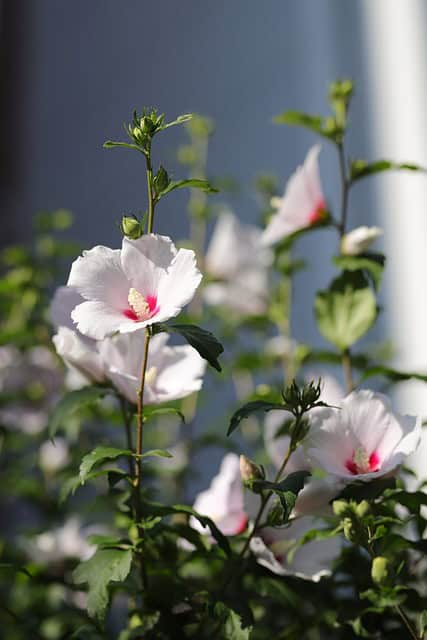
The Rose of Sharon, scientifically known as Hibiscus syriacus, is a resilient flowering shrub renowned for its large, showy blooms. Flowering from mid-summer through early fall, it produces flowers in various colors, including white, blue, pink, and purple. One of the standout features of this shrub is its ability to thrive in a wide range of soil conditions and adaptability to urban environments.
Besides its beauty, the Rose of Sharon is also low-maintenance, making it an excellent choice for busy gardeners. It can be pruned to maintain its shape and encourage denser foliage. Additionally, it can reach heights of 8 to 12 feet, providing a lovely backdrop for shorter flowering plants. Its flowers attract pollinators like bees and butterflies, making it a perfect addition to a pollinator-friendly garden.
Hibiscus (Hibiscus rosa-sinensis)
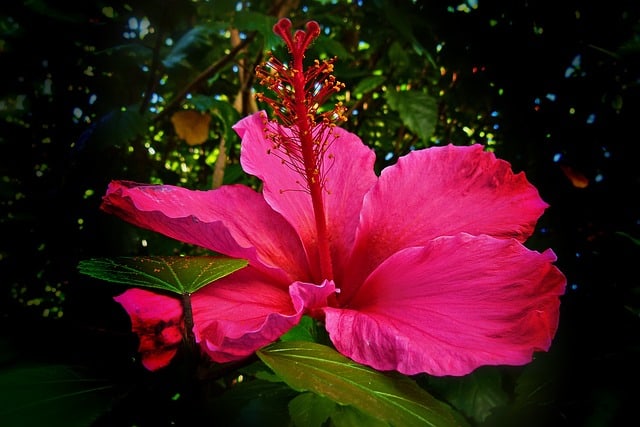
Often associated with tropical settings, Hibiscus rosa-sinensis brings a stunning flair to any garden. Known for its flamboyant, trumpet-shaped flowers that can be as wide as 6-8 inches, this shrub typically blooms from late spring through fall. With colors ranging from deep reds to bright yellows and corals, it’s a true showstopper.
Hibiscus thrives in warm, sunny environments and prefers well-draining soil. In colder climates, it can be grown in pots and brought indoors during the winter. Regular watering and fertilization can help maintain its health and flowering schedule. The striking blooms are not just visually appealing; they also attract hummingbirds and various butterfly species, enhancing the garden’s liveliness.
Butterfly Bush (Buddleja spp.)
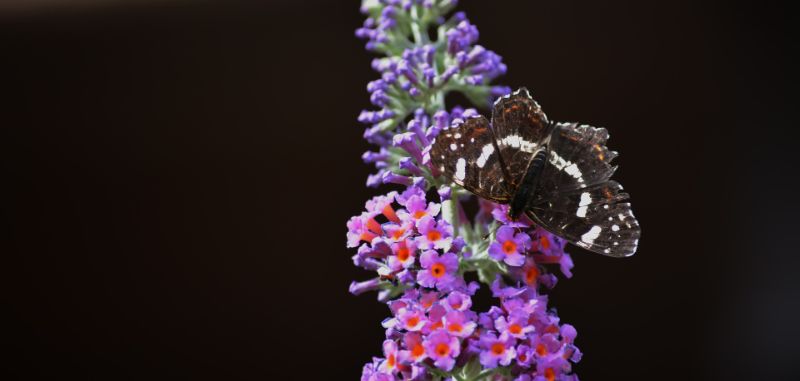
True to its name, the Butterfly Bush, or Buddleja, is a magnet for butterflies and other pollinators. Blooming all summer long, this shrub produces fragrant, elongated flower spikes that can be purple, white, pink, or blue. The butterfly bush not only brightens gardens with its vibrant colors but also emits a sweet nectar that becomes a haven for butterflies and bees, making it a favorite for nature lovers.
Butterfly bushes are incredibly adaptable and drought-tolerant once established, which makes them ideal for low-maintenance gardens. Pruning back the previous year’s growth in early spring promotes healthier blooms and maintains the bush’s shape. These shrubs can grow from 3 to 10 feet tall, depending on the species, providing various options for different gardening spaces.
Crape Myrtle (Lagerstroemia indica)
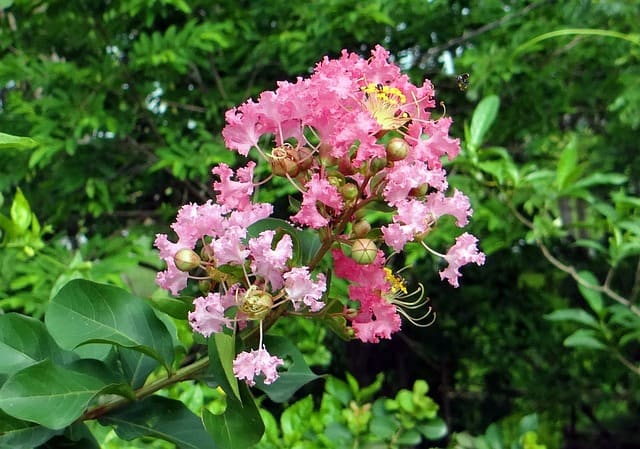
The Crape Myrtle is another stunning perennial that blooms from late spring through summer, known for its vibrant clusters of flowers in pink, red, lavender, and white hues. Its airy foliage and striking blossoms create a beautiful contrast, making it a popular choice among gardeners.
This shrub prefers full sun and well-drained soil, and its drought resistance makes it a practical choice for many climates. The Crape Myrtle also offers spectacular fall foliage with shades of orange and red, while its bark peels away in the winter to reveal a smooth, attractive trunk. Varieties vary widely in size, from compact bushes to towering trees, allowing gardeners to select the perfect one for their space.
Smooth Hydrangeas (Hydrangea arborescens)

Hydrangea arborescens, commonly known as Smooth Hydrangeas, is a stunning shrub appreciated for its large, round flower clusters known as mopheads, typically white or pale green. Blooming throughout summer, these flowers gradually take on a rosy hue, especially in the fall.
These shrubs thrive in part to full shade and prefer moist, well-drained soil, making them an excellent choice for shaded garden spots. They can grow up to 3-5 feet tall and can be pruned annually to encourage new growth and a denser bloom. The smooth hydrangeas also provide excellent cut flowers, bringing their summer beauty indoors.
Panicle Hydrangeas (Hydrangea paniculata)
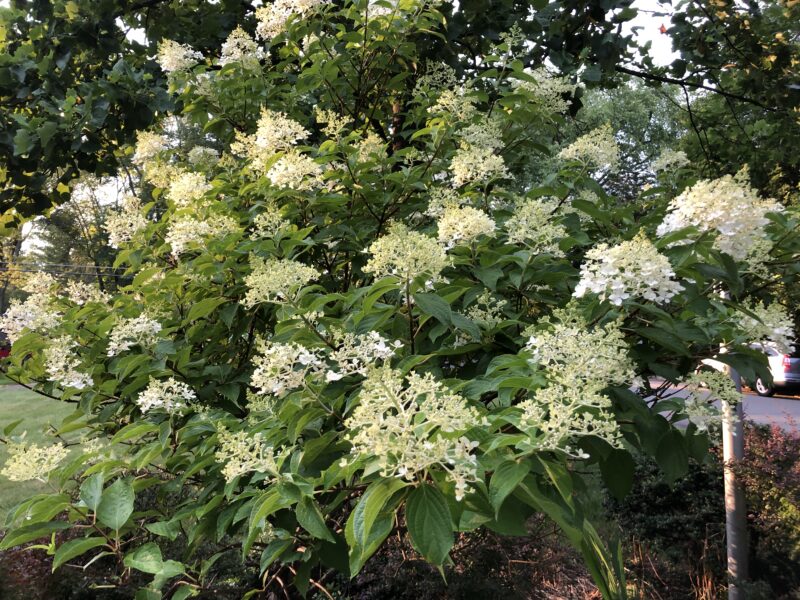
Unlike their Smooth counterparts, Hydrangea paniculata blooms with cone-shaped flower clusters that can be quite large, often reaching up to 12 inches. These panicle hydrangeas flower from summer into fall, offering a prolonged display of color in shades of white, cream, pink, or even deep burgundy as the blooms mature.
These adaptable shrubs can thrive in a variety of conditions, making them versatile in landscape design. They benefit from full sun to part shade and prefer well-draining soil with adequate moisture. Pruning in late winter or early spring encourages vigorous blossoms, allowing these hardy hydrangeas to shine in your garden all summer long.
Rock Rose (Cistus pulverulentus)
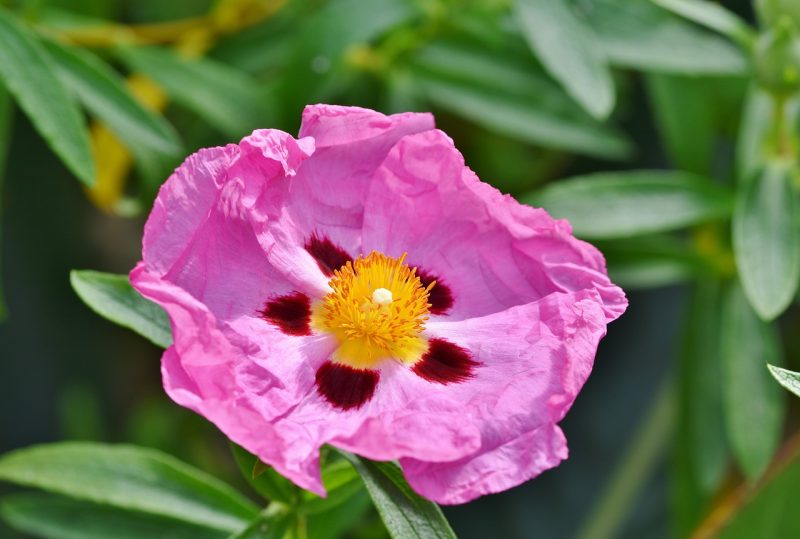
If you’re looking for a shrub that exudes charm and resilience, consider the Rock Rose, or Cistus pulverulentus. This evergreen shrub, known for its stunning papery flowers that bloom from late spring to summer, can showcase colors ranging from white to deep pink.
The Rock Rose thrives in dry, sandy soils, making it perfect for low-maintenance gardens or drought-tolerant landscapes. Its unique, crinkled flowers appear in the morning and fade by the afternoon, adding a touch of whimsy to the garden. Furthermore, the shrub typically grows to about 2-4 feet tall and can be easily shaped with light pruning.
Weigela (Weigela florida)
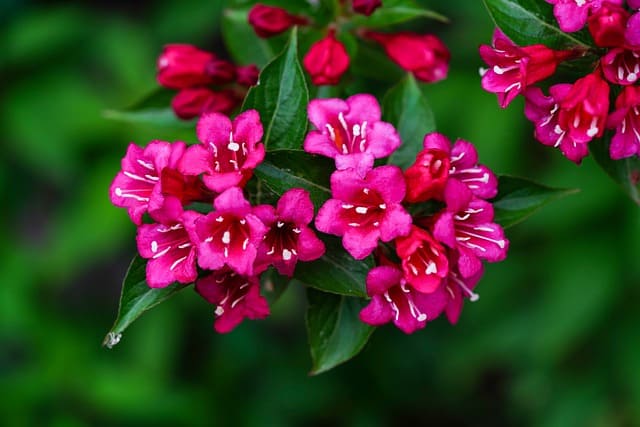
The Weigela, especially Weigela florida, is a beloved choice for its abundant bell-shaped flowers that bloom throughout spring and summer. With flowering hues in shades of pink, red, and white, it creates vibrant mounds of color that beautify any yard.
With its ability to thrive in various soil types and its adaptability to both sun and partial shade, Weigela is a fantastic choice for different landscapes. Additionally, the plant is quite easy to care for—minimal pruning will keep it tidy and encourage blooming. Plus, its nectar-rich flowers attract hummingbirds, making your garden a lively habitat.
Azalea (Rhododendron spp.)

Azaleas, members of the Rhododendron family, are known for their showy, somewhat delicate blooms that can light up any garden in spring and early summer. Fast-forward to summer, and certain azalea varieties continue to offer striking colors, although they are often at their peak earlier in the season.
These shrubs come in a multitude of colors and bloom forms. Azaleas thrive in acidic, well-drained soil and prefer partial shade, making them ideal for woodland gardens. While they may require a bit more care in terms of watering and soil amendments, the show they put on in the garden makes the effort worthwhile.
Lavender (Lavandula angustifolia)
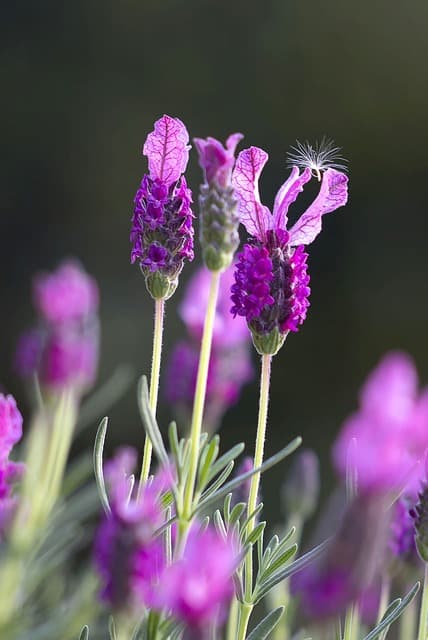
Lavandula angustifolia, or English lavender, is renowned for its delightful fragrance, beautiful purple spikes, and silvery-green foliage. Blooming late spring through summer, lavender not only adds beauty but also attracts pollinators and beneficial insects to your garden.
This drought-tolerant shrub thrives in full sun and well-drained soil, making it an excellent addition to herb gardens and landscapes. The flowers can be harvested for culinary use, potpourri, or essential oils. Regular pruning helps maintain its shape and encourages robust blooming each year.
Meadowsweet (Spiraea alba)
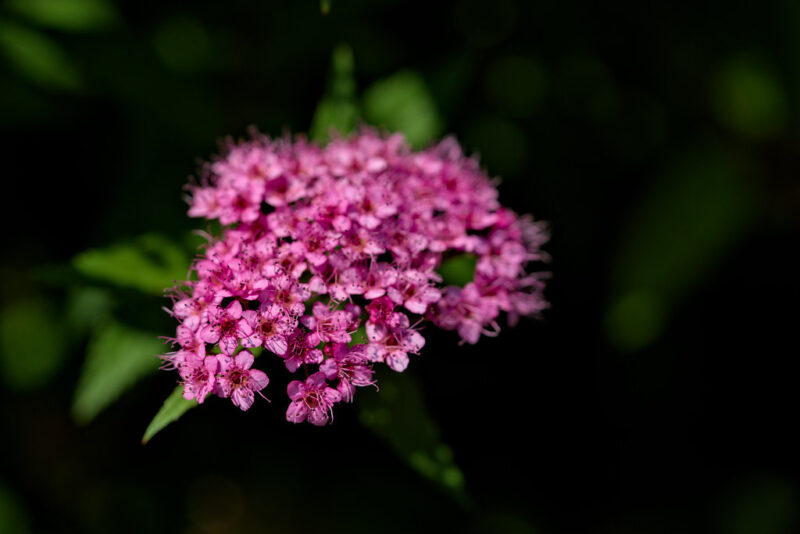
The Meadowsweet, or Spiraea alba, is a lovely fluffy shrub that blooms with clusters of delicate white flowers throughout the summer. Its graceful appearance and subtle scent make it a charming addition to any garden.
This shrub is resistant to pests and pollution, thriving in marshy or wet soil conditions, making it ideal for rain gardens or near bodies of water. It typically grows to about 3-5 feet tall and can be shaped through light pruning to encourage a bushy appearance. The Meadowsweet not only enhances the aesthetic of your garden but also provides nectar for bees, creating a thriving ecosystem.
Chaste Tree (Vitex agnus-castus)

The Chaste Tree, or Vitex agnus-castus, is a unique flowering shrub that typically blooms from late spring through summer, producing long spikes of violet-blue flowers that are aromatic and attract bees and butterflies.
These trees can reach heights of 10 to 20 feet and thrive in well-drained soil and full sun. They are drought-tolerant once established, which makes them suitable for low-maintenance gardens. The foliage is evergreen in warmer climates, providing year-round beauty. The Chaste Tree’s long-lasting blooms create vibrant displays, elevating the overall charm of your garden.
Glossy Abelia (Abelia × grandiflora)
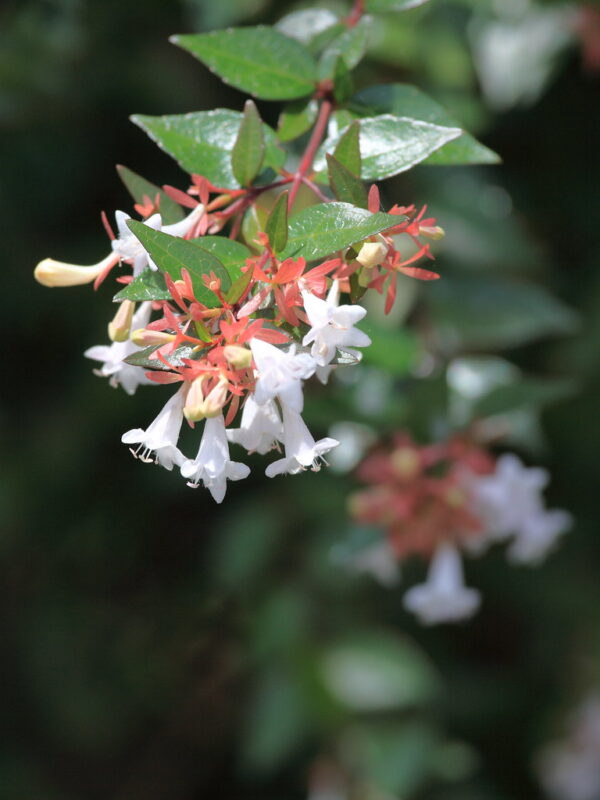
The Glossy Abelia is a semi-evergreen shrub known for its continuous blooming from spring to fall. Its small, tubular flowers come in white to pale pink hues, and when they bloom, they produce a delightful fragrance that attracts hummingbirds.
Glossy Abelia is hardy and adaptable, thriving in a variety of soils and conditions. It prefers full sun to partial shade and can tolerate drought once established. Growing to a height of 3-6 feet, this shrub works well as a low hedge or accent plant. Regular pruning can keep the plant tidy and encourage more blooms.
Beautybush (Kolkwitzia amabilis)
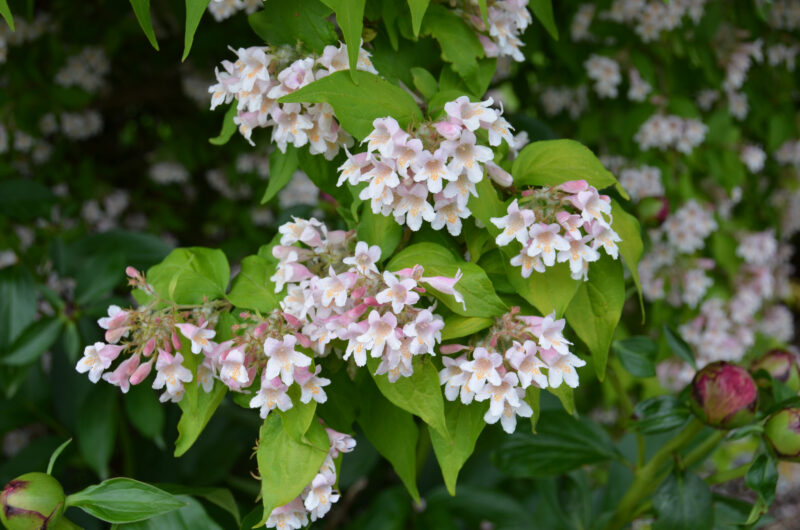
Kolkwitzia amabilis, commonly known as Beautybush, is celebrated for its graceful arching branches and delightful pink flowers that bloom in late spring to early summer. These blooms have a sweet fragrance and can add an invigorating scent to your garden.
This shrub is low-maintenance and grows quite well in average soil, preferring sunny to partially shaded locations. Typically growing 6-10 feet tall, it can be shaped easily with pruning, encouraging denser growth. Beautybush’s captivating blooms and overall appearance create a stunning focal point in any landscape design.
Lilacs (Syringa ‘Bloomerang’)
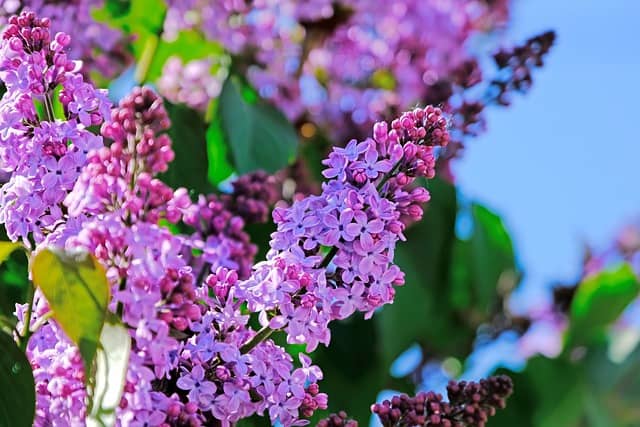
The ‘Bloomerang’ Lilac is a revolutionary cultivar that extends the traditional lilac bloom period into the summer. Known for its fragrant, purple flowers, this shrub blooms continuously from spring until late summer, ensuring vibrant splashes of color all season long.
Lilacs thrive in full sun and well-drained soil. They can reach a height of up to 4-5 feet and should be pruned shortly after flowering to encourage new blooms. With their pleasing scent and adaptability, ‘Bloomerang’ Lilacs create a delightful atmosphere in any garden and are a must-have for lilac lovers.
Shrub Roses (Rosa)
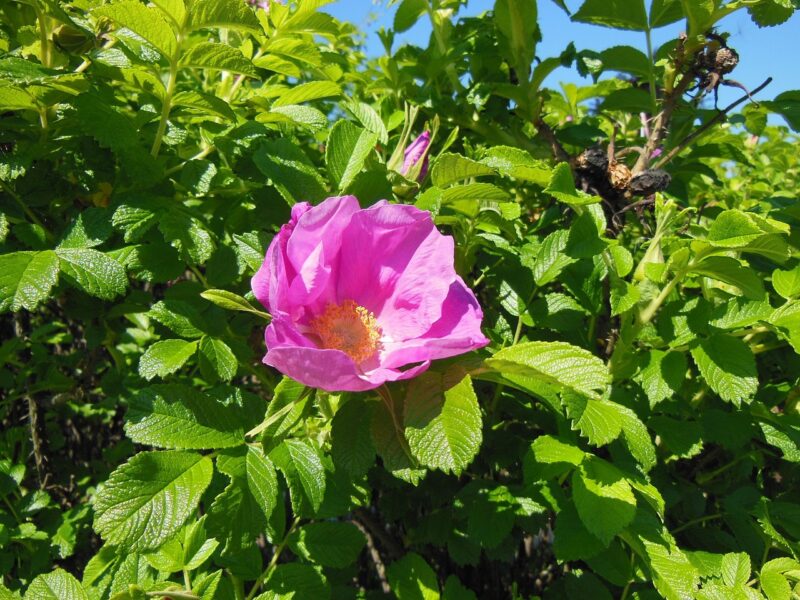
Shrub roses demonstrate an extraordinary ability to produce an abundance of blooms throughout the summer. With countless varieties available, these hardy shrubs can offer vibrant colors, unique shapes, and captivating fragrances, appealing to numerous gardening styles.
They can flourish in various conditions and are relatively low-maintenance, requiring only occasional pruning and deadheading to promote blooming. Their relentless production of flowers not only beautifies your garden but also makes them perfect for cutting and creating floral arrangements for the home.
Tea Rose (Rosa heirloom)
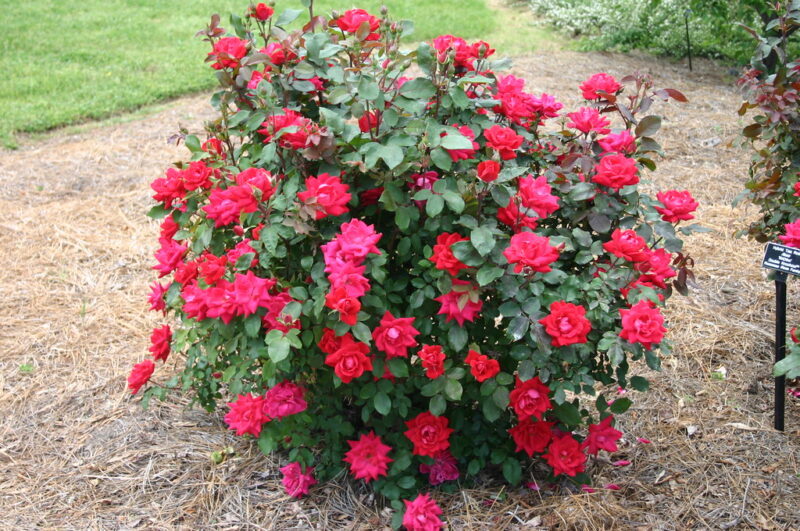
Tea Roses, specifically Rosa heirloom, are cherished for their exquisite fragrance and elegant blooms. Often found in gardens from the 19th century, these roses bloom repeatedly throughout summer, showcasing stunning colors ranging from soft pastels to bright hues.
Tea roses require full sun and rich, well-draining soil to thrive. They do need regular watering and maintenance, including pruning to promote healthy blooms and prevent disease. Their classic beauty and enduring popularity make them favorites among rose enthusiasts.
Chokeberry (Aronia melanocarpa)
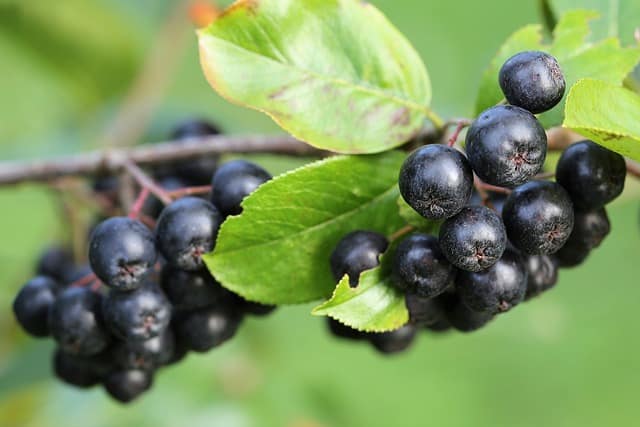
The Chokeberry, or Aronia melanocarpa, is a lesser-known flowering shrub that boasts beautiful white flowers in spring, followed by striking dark berries in summer. Its vibrant foliage in autumn further adds to its appeal.
Chokeberries are tolerant of wet conditions and adapt well to various soil types, making them versatile for different gardening scenarios. They typically reach 3–6 feet in height and can be maintained easily with occasional pruning. In addition to its ornamental qualities, the berries are edible and packed with antioxidants, attracting both wildlife and health-conscious gardeners.
Mountain Laurel (Kalmia latifolia)
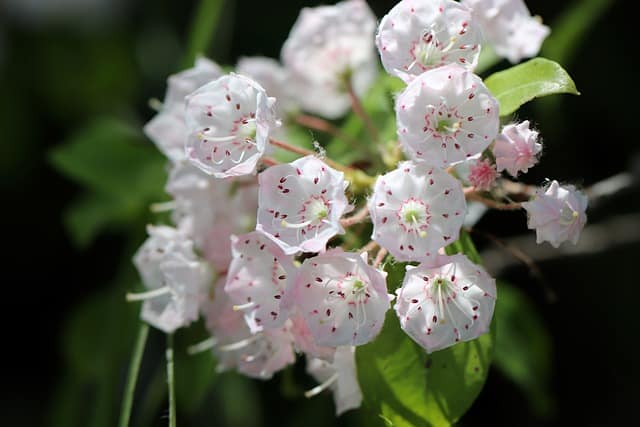
Kalmia latifolia, or Mountain Laurel, is a stunning flowering shrub known for its unique, star-shaped blossoms that bloom in late spring to early summer. This native species blooms in shades of pink and white, creating a beautiful display against its evergreen foliage.
Mountain Laurel thrives in acidic, well-drained soil and prefers partial shade, making it a lovely choice for woodland gardens. Typically, it grows to a height of 5 to 15 feet, providing privacy and shelter. Its deer-resistant qualities and vibrant flowers make it a fantastic option for gardens looking to attract a variety of wildlife.
Shrubby Cinquefoil (Potentilla fruticosa)
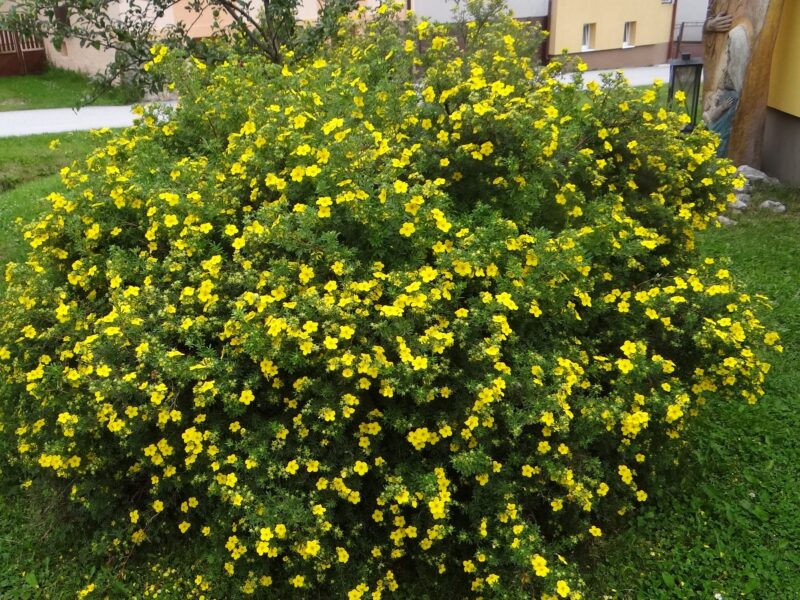
The Shrubby Cinquefoil, or Potentilla fruticosa, is a hardy shrub that produces cheerful yellow, orange, or white flowers throughout summer. Its long flowering season and low-maintenance care make it popular for gardens needing consistent color.
This shrub easily adapts to various soil types and environmental conditions, thriving in sun to partial shade. It grows about 2-3 feet tall and can be pruned to maintain its shape. The Shrubby Cinquefoil acts as an excellent ground cover, filling gaps in flower beds or borders while providing valuable nectar for pollinators.
Bottlebrush Buckeye (Aesculus parviflora)
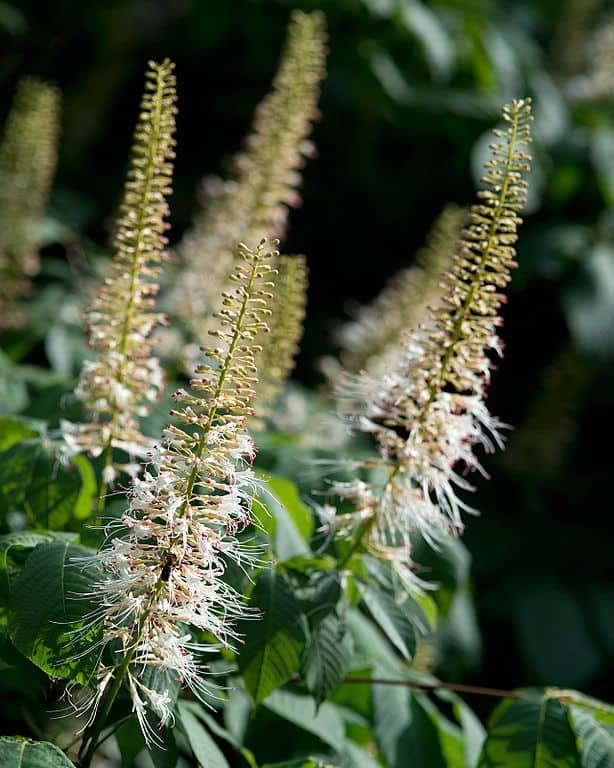
The Bottlebrush Buckeye, known as Aesculus parviflora, features fascinating spikes of white flowers resembling brushes, blooming from late spring through summer. This stunning shrub provides an eye-catching display in any garden, with its unique, architectural flower clusters.
Typically reaching 8-12 feet in height, the Bottlebrush Buckeye thrives in well-drained soil and can adapt to partial shade. While it does require some space to grow, its lush foliage and spectacular blooms will reward gardeners with a vibrant display that pleases the eye throughout the sunny months.
Sweet Bay Magnolia (Magnolia virginiana)

The Sweet Bay Magnolia, or Magnolia virginiana, showcases lush, green foliage and stunning creamy-white blooms that exude a sweet, citrus-like fragrance in early summer. Its unique flowers make it attractive to both pollinators and gardeners alike.
While it prefers moist, slightly acidic soil, the Sweet Bay can tolerate varying conditions, allowing it to thrive in different garden settings. This shrub grows to be about 10-20 feet tall and can be pruned to maintain a desired shape. Its captivating blooms and fragrant leaves create a serene oasis in any garden space.
Oleander (Nerium oleander)
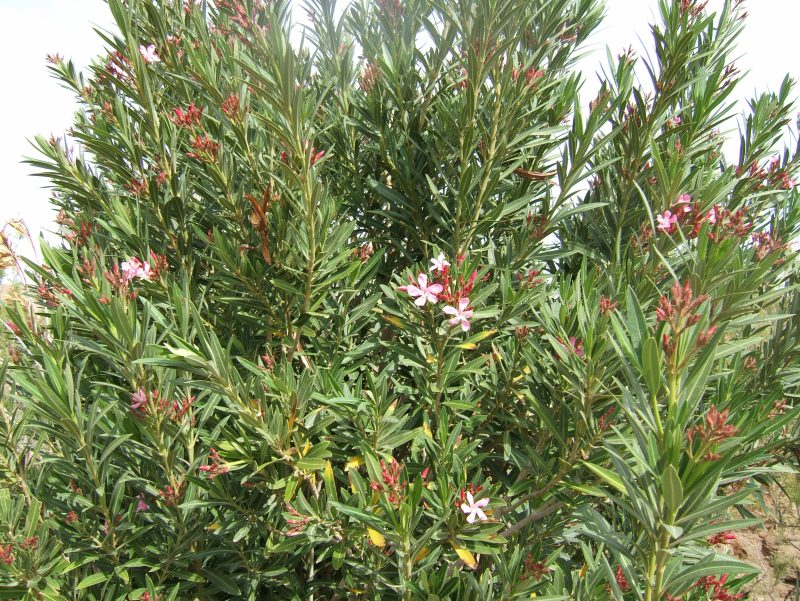
Nerium oleander is recognized for its beautiful, trumpet-shaped flowers that bloom throughout summer. With hues ranging from pink to white and yellow, this shrub adds dramatic flair to gardens in warmer climates.
It’s essential to note that oleander is toxic if ingested, so keep this in mind if you have pets or small children. However, its disease resistance and drought-hardiness make it popular in Mediterranean-style gardens. Oleander can grow substantially, often reaching heights of 10 feet or more, forming a floral privacy screen or hedge.
Texas Lantana (Lantana urticoides)
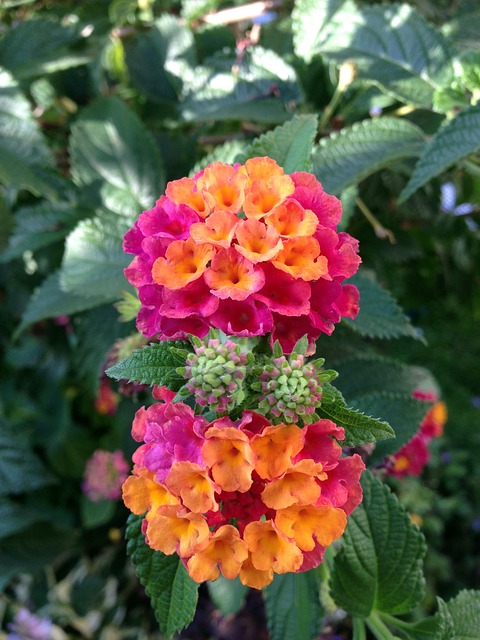
Texas Lantana, or Lantana urticoides, is a drought-tolerant flowering shrub known for its petite, colorful clusters of blooms that change color as they mature. These vibrant flowers attract butterflies and other pollinators, adding liveliness to any garden.
Thriving in hot, dry conditions, Texas Lantana can be an excellent choice for low-maintenance gardens. Its ability to adapt to poor soil conditions makes it a hardy landscape addition. This shrub typically grows 2-4 feet tall, offering vibrant pops of color throughout summer while meeting the needs of pollinators in your local ecosystem.
Flame of the Woods (Ixora)
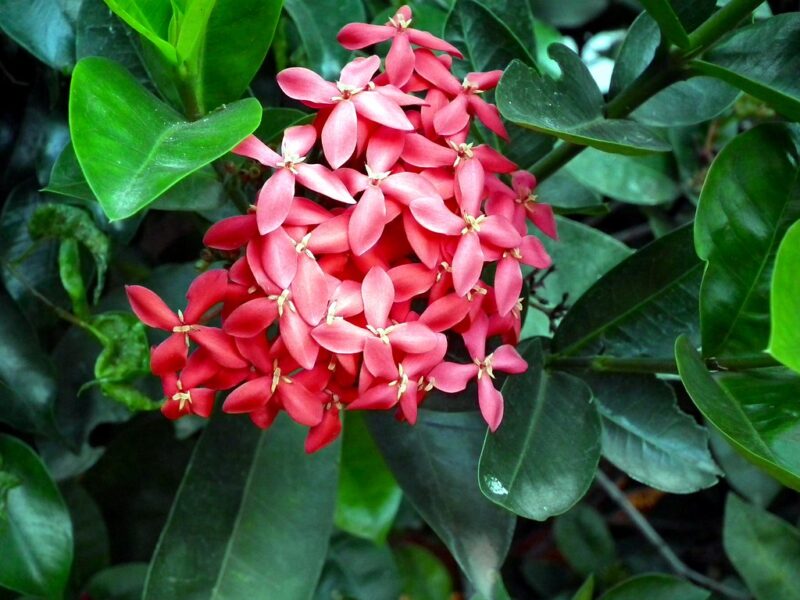
Ixora, often known as Flame of the Woods, boasts clusters of small, tubular flowers that bloom in colors ranging from fiery red to orange and yellow. Blooming throughout summer, this tropical shrub adds a splash of vibrancy to any garden setting.
This heat-loving shrub thrives in well-drained, nutrient-rich soil, preferring full sun to partial shade. It grows to heights of about 3-4 feet and can be easily shaped through pruning. Its ability to attract butterflies and hummingbirds makes the Flame of the Woods an excellent choice for gardeners seeking to create a lively outdoor space.
Bougainvillea

Bougainvillea is the epitome of tropical flair, known for its vibrant bracts that bloom throughout the summer months. With hues of purple, pink, red, and even white, Bougainvillea transforms gardens and patios into stunning displays of color.
This hardy shrub thrives in warm, sunny climates, preferring dry conditions and well-draining soil. Bougainvillea can be grown as a shrub, vine, or even a small tree, making it versatile for a variety of landscaping needs. Regular pruning encourages prolific blooming and prevents the plant from becoming too unruly.
St John’s Wort (Hypericum spp.)
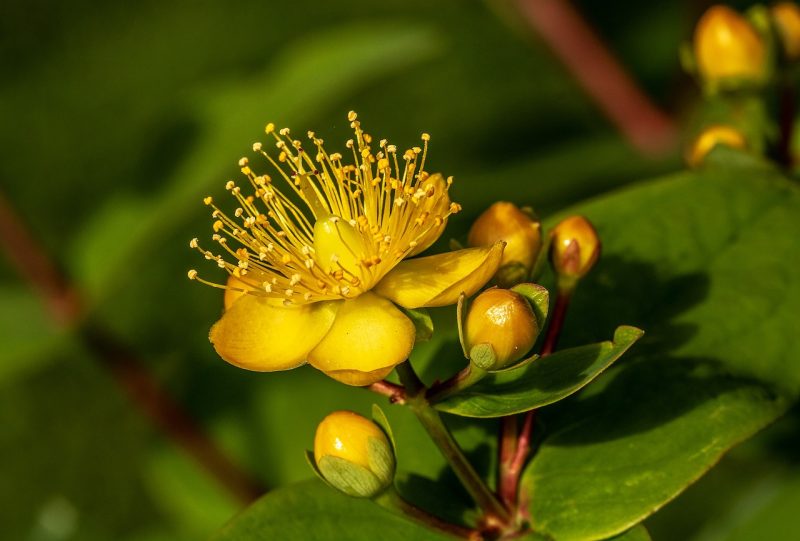
St John’s Wort, specifically the Hypericum spp., showcases cheerful yellow flowers that bloom throughout the summer, creating a bright addition to any garden. Recognized for its medicinal properties as well, this shrub offers both aesthetic and practical benefits.
St John’s Wort thrives in full sunlight and can handle various soil types, offering versatility for gardeners. Typically growing to about 2-4 feet in height, it can be used as a border, ground cover, or specimen plant. Its vibrant flowers attract pollinators while providing the added benefit of lush foliage.
Buttonbush (Cephalanthus occidentalis)

Cephalanthus occidentalis, or Buttonbush, is known for its unique, spherical flower clusters consisting of tiny white blooms. This shrub begins to flower in midsummer, and its unique form creates a striking appearance in the landscape.
Buttonbush thrives in wet soil and is commonly found near water bodies, making it a perfect choice for rain gardens or wetland areas. Its ability to attract butterflies, bees, and other pollinators enhances its popularity among wildlife gardeners. Growing to about 3-10 feet in height, the Buttonbush makes a valuable addition to any biodiversity-conscious garden.
Salt Cedar (Tamarix ramosissima)

The Salt Cedar, or Tamarix ramosissima, is a distinctive shrub appreciated for its feathery pink flowers that bloom throughout the summer. Though it prefers sunny, dry environments, the shrub can also tolerate saline soils, making it ideal for challenging gardening conditions.
Tamarisk grows 10-20 feet in height and can be used in windbreaks or as a landscape specimen, providing beauty and utility in arid regions. Regular maintenance is necessary, including pruning, to prevent it from becoming invasive, but its unique blooms contribute significantly to summer color.


